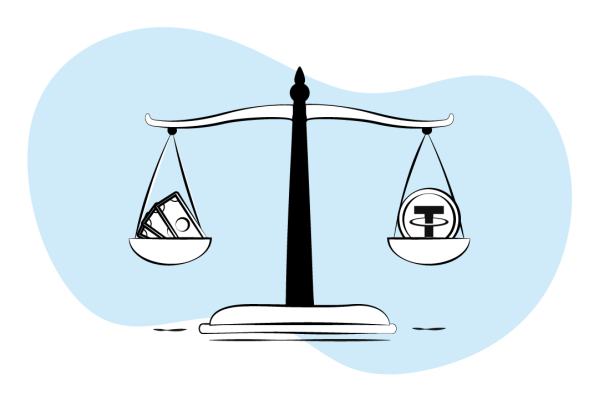Since the emergence of stablecoins, cryptocurrency trading has become more accessible to traders for the simple fact that they now have a fiat point of reference for these internet assets. And Tether (USDT) is just one of the many.
For some, it’s the rockstar of stablecoins. For others, it’s a suspicious printing machine meant to manipulate cryptocurrency prices.
But all opinions aside, let’s see what Tether (USDT) is all about.
What is Tether (USDT)?
In the Cambridge Dictionary, Tether refers to a rope or chain used to tie, generally an animal, to a post or other fixed place. However, it also means using a mobile phone as a wireless internet connection to which you can connect other devices.
And the second definition is closer to what Tether means in the cryptocurrency space.
Tether is one of the first stablecoins and currently the most popular, having the highest liquidity. The concept promoted through USDT as a stablecoin is that every token is backed by one US Dollar. Hence, the 1-on-1 ratio between USDT and USD should almost always stay at the same level.
This way, traders can use in their activity a cryptocurrency ‘tethered’ to the real-world US Dollar.
It was initially launched as RealCoin in July 2014 and rebranded as Tether in November by Tether Ltd. After the rebrand, Tether started trading in February 2015.
In June 2020, it surpassed XRP in terms of market cap and climbed to the third position, right behind Ethereum and Bitcoin. Although throughout 2021, other cryptocurrencies ascended over USDT in terms of market cap, in terms of 24h trading volume, Tether has constantly kept the first position.
Because of the one-on-one connection to the US Dollar, USDT allowed users to keep their funds in a cryptocurrency that retains the same value as the fiat currency.
The benefit of it comes in the fact that cryptocurrency traders didn’t have to pay additional fees for fiat transactions and stopped waiting days for their funds to reach a destination. Additionally, from 2018 to 2019, governments started applying income taxes on cryptocurrency profits. However, the taxes mostly apply at the moment a trader exchanges his cryptocurrency for fiat. So, with stablecoins like Tether, traders can retain and move their funds at a fixed value without exchanging their cryptocurrency for fiat.
What are Stablecoins?

The cryptocurrency community came up with stablecoins – cryptocurrencies that can be used without worrying about price volatility for daily trading and spending.
These days stablecoin are usually launched with one of these two main goals in mind. Either to become a widely used stable cryptocurrency or as a marketing channel used by cryptocurrency exchanges to attract more users to their platforms.
Either way, these companies have to maintain their stablecoin’s peg by gaining trust. And usually, they do this by showing a form of collateral and/or through algorithmically manipulating the supply.
Collateral Pegging
The Collaterals have the role in proving that a said stable cryptocurrency is worth what the company behind it says it is.
Three main types of collateral grant stablecoins value:
- Fiat
- Assets
- Cryptocurrency
Fiat Collaterals
Stablecoins backed by fiat are pegging a mainstream currency like USD, Euro, or Japanese Yen. So, every stablecoin that says it’s worth 1 USD is equal to one coin/token and should have a corresponding amount of fiat currency funds in the company’s bank account.
Asset Collaterals
The most common asset collaterals used to back stablecoins are Gold, Silver, and Oil. In the same way as the fiat-backed stablecoins, companies providing cryptocurrencies pegging assets have to own an amount of that asset that corresponds to the value their token is worth.
Cryptocurrency Collaterals
Stablecoins can also be backed by one or more cryptocurrencies. This form of collateral comes with the main advantage that the collaterals can always be checked on the blockchain.
Algorithmic Pegging
In order to better control the price of a cryptocurrency, companies are providing a stablecoin set up rules to manipulate the supply of coins as the demand goes up and down.
So, when many people buy into the cryptocurrency, the algorithm will increase the number of units to ensure that the coin doesn’t over appreciates and destabilize. And in the same manner, the algorithm will reduce the number of coins when traders are selling out in order to prevent depreciation.
How is USDT Stable?
At its core, USDT doesn’t have its own blockchain. It operates as a second-layer digital token on the Bitcoin (on Omni and Liquid Protocol), Ethereum (as an ERC20 token), EOS, Tron, Algorand, and OMG blockchains.
All tethers are secured in their respective blockchains and pegged at 1-to-1 with a matching Fiat currency, such as 1 USDT to 1 USD, being backed 100% by Tether’s reserves.
USDT controversies
Tether is the most used and reliable stablecoin out there because of its high liquidity. However, the controversies kept popping up around the company.
The main controversy surrounding Tether comes with the fact that USDT is minted and managed by a central entity (similar to a bank). That goes against the wish for decentralization crypto users have, especially considering the fact that Tether froze over $46 Million of assets over the years.
Moreso, USDT faces some skepticism in regard to its funds. In early 2019, Tether’s lawyers admitted the company only 74% of the USDT circulating supply is backed by fiat currency. Another concern is the USDT’s ties with the crypto exchange Bitfinex. Bitfinex and Tether Holdings Ltd. are sister companies and are constantly facing class lawsuits where they are accused of working to manipulate the bitcoin markets.
What Other Stablecoins are Out There?

Besides USDT, there are other stablecoins that come to serve the crypto market. Whether they come with a goal to be better than Tether or simply draw more users into an exchange, they provide a steady price and a safe medium of exchange for crypto users.
USDC
USD Coin (USDC) is one of the largest stablecoins by market cap, and it currently stays in the top 10 cryptocurrencies on CoinMarketCap. It is an ERC20 token built on the Ethereum Blockchain, and it was launched in 2018 by Center Consortium, a collaboration between Circle Internet Financial and Coinbase.
Since 2018, USDC has seen significant growth. And because it’s an ERC20 token, it can be easily integrated with smart contracts.
USDC is backed by a one-to-one fiat currency reserve which is regularly audited to confirm that the funds are available in the company’s accounts.
BUSD
Binance USD (BUSD) is to not be confused with the BNB token. BNB is a utility token, while BUSD is a stablecoin.
BUSD is developed by Paxos in partnership with Binance, with Paxos being the USD custodian and issuer of BUSD.
The BUSD is backed by USD on a 1-on-1 ratio and neither Binance nor Paxos charge a fee for the purchase or redemption of the stablecoin.
DAI
DAI presents itself as the only decentralized stablecoin available on the market. It was built by the MakerDAO development team on the Ethereum Blockchain. However, the coin isn’t controlled by the development team nor by any other centralized authority.
DAI is not backed by any fiat currency but uses a multi-collateral script in which the coin is created when a collateralized debt position is created, locking Ethereum into a smart contract. The contract holds the staked coins, which can be unlocked at a later time using DAI.
Key Takeaways
- Tether (USDT) is one of the first stablecoins and is currently the most popular, having the highest liquidity.
- Stablecoins are cryptocurrencies with steady prices, backed through collateral or algorithmic pegging.
- The USDT is supposed to be backed by USD at a 1-on-1 ratio through the accounts of Tether Ltd.
- Although USDT is the most popular stablecoin, it’s surrounded by controversies related to Tether’s Ltd’s capacity to cover the coin’s volume with fiat and its relations with Bitfinex.
- Some other popular stablecoins are USDC, BUSD, and DAI.



